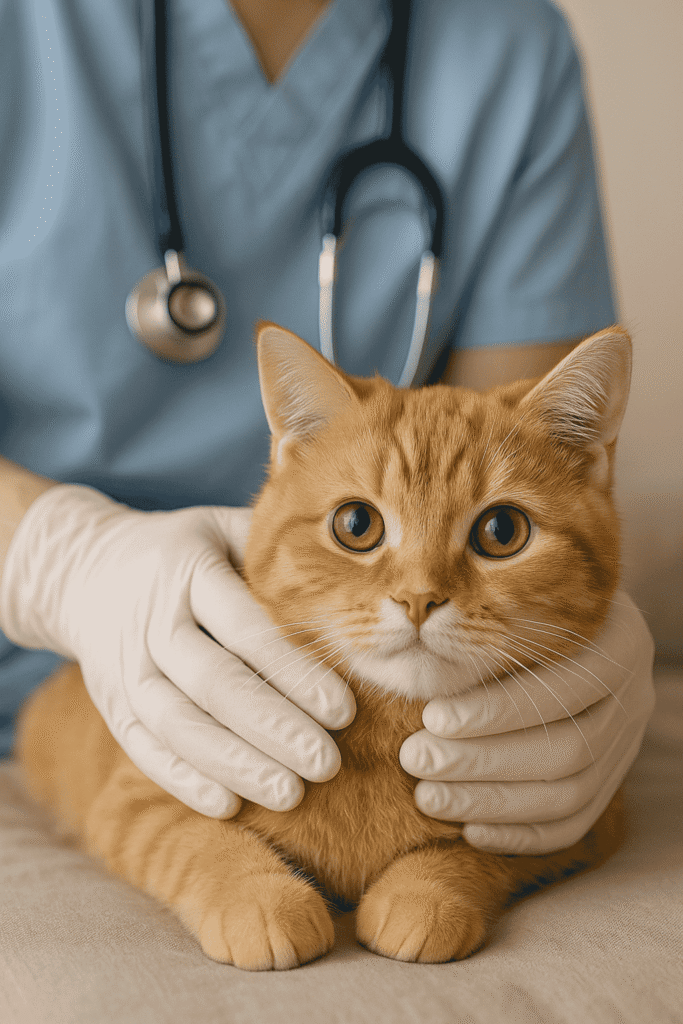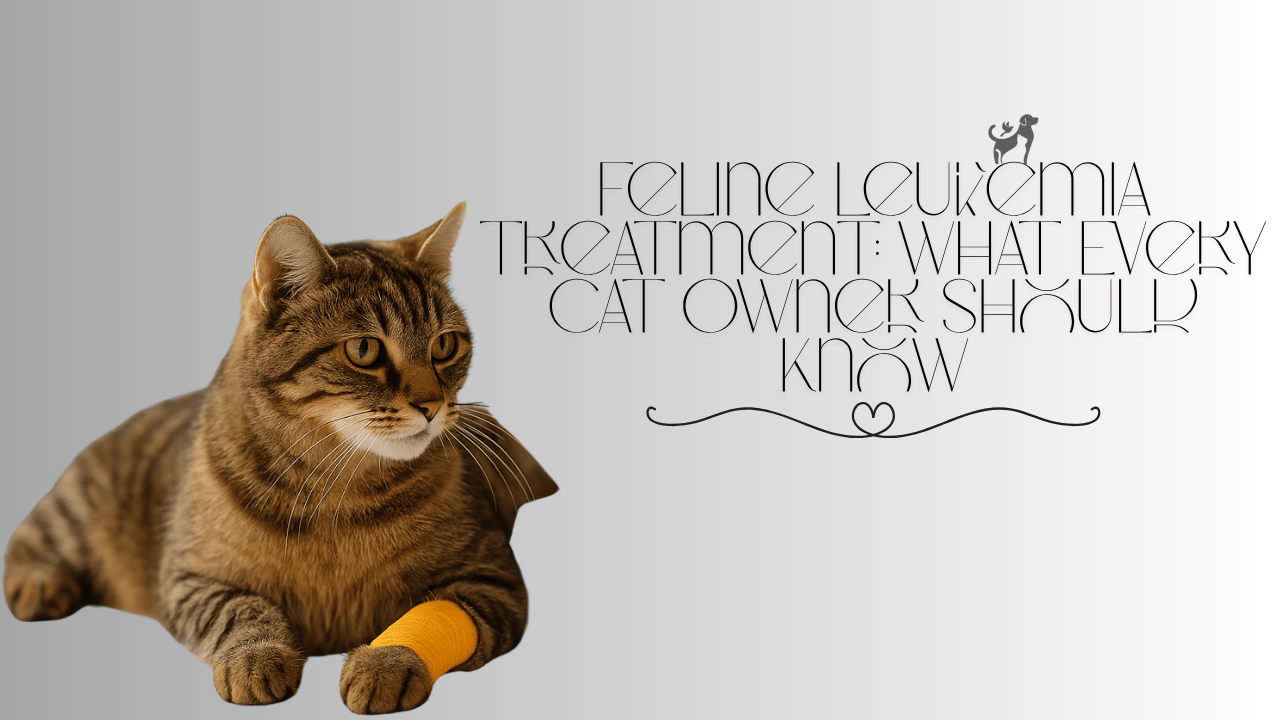Hearing that your cat has feline leukemia is heartbreaking — but it’s not a death sentence. With the right care, many FeLV-positive cats can live comfortable, happy lives. In this guide, we’ll break down everything you need to know about feline leukemia treatment, from vet-prescribed therapies to supportive care you can give at home. Whether your cat was just diagnosed or you’re looking for better ways to support their health, this article will walk you through it — gently and clearly.

What Is Feline Leukemia (FeLV)?
Feline Leukemia Virus (FeLV) is a retrovirus that weakens a cat’s immune system and makes them vulnerable to infections, anemia, and cancers like lymphoma. It’s spread through saliva, nasal secretions, and sometimes from mother to kitten.
According to PetMD, FeLV is one of the most common infectious diseases in cats, affecting around 2–3% of the feline population in the U.S. While there is no cure, supportive treatment can help manage symptoms and improve quality of life.
How Is FeLV Diagnosed?
FeLV is usually diagnosed through a blood test — typically an ELISA test. If positive, your vet may confirm with a follow-up IFA test or PCR test to determine how advanced the virus is.
Common signs that prompt testing include:
- Persistent fever
- Loss of appetite
- Chronic respiratory infections
- Enlarged lymph nodes
- Weight loss
FeLV can be tricky because many cats show no symptoms for months or even years.
Can Feline Leukemia Be Treated?
There is no cure for FeLV, but treatment focuses on:
- Strengthening the immune system
- Managing secondary infections
- Supporting organ function
- Improving quality of life
Early diagnosis + consistent care = longer, healthier life.
Medical Treatments for Feline Leukemia
Most vets take a customized approach to feline leukemia treatment, depending on the cat’s stage of illness and current symptoms. The goal is to boost immunity, treat infections quickly, and improve your cat’s daily comfort.
Veterinary care often includes a mix of medications, supplements, and routine monitoring. Treatment may involve:
1. Antiviral Medications
Drugs like interferon-alpha or zidovudine (AZT) may help reduce viral load, although they are not a cure.
2. Immune Boosting Injections
Some vets use recombinant feline interferon omega (rFeIFN-ω), which may help strengthen immune response in some cats.
3. Antibiotics and Antifungals
These are used when FeLV-positive cats get infections that their body struggles to fight on its own.
4. Steroids or Chemotherapy (for Lymphoma)
If FeLV has triggered cancer, treatments may include chemotherapy. This is case-specific and should be discussed in-depth with your vet.
5. Frequent Vet Monitoring
Routine bloodwork helps monitor red blood cell counts, organ function, and detect secondary illnesses early.
Pro Tip: Not all vets agree on aggressive treatments. Ask your vet what the goals of care are for your cat: longer life, better quality, or both?
At-Home Support and Daily Care
Caring for a FeLV+ cat at home means keeping their environment low-stress, clean, and consistent.
- Keep them indoors only — they’re vulnerable to common germs
- Avoid raw food (higher risk of bacterial exposure)
- Clean food/water bowls and litter daily
- Reduce stress and offer cozy, quiet resting spaces
- Limit exposure to other pets if unvaccinated
At Fluffze.com, we’ve seen how routine, stability, and love make a huge difference in how FeLV-positive cats thrive.
Nutrition Tips for FeLV-Positive Cats
Good nutrition is your cat’s first line of defense. Stick to:
- High-quality commercial food (wet and dry mix for hydration and calories)
- Easy-to-digest protein (like chicken, turkey, or lamb)
- Omega-3 supplements (may reduce inflammation)
- Vet-approved immune boosters (like L-lysine or B-complex vitamins)
Avoid trendy “raw” diets unless cleared by your vet. You want a diet that supports your cat’s gut and immune system — not challenges it.
Protecting Other Cats in the Household
FeLV can be transmitted between cats through close contact — grooming, sharing bowls, or fights.
What to do if you have more than one cat:
- Keep FeLV+ cats separate from negative cats
- Avoid shared food/water dishes
- Vaccinate healthy cats against FeLV
- Talk to your vet about group housing safety
The ASPCA recommends isolating FeLV+ cats in multi-cat households to reduce risk of transmission.
Real-World Insight from Cat Owners
“My cat Luna was diagnosed with FeLV at 2 years old. I was devastated at first, but with routine checkups and a strict indoor-only life, she lived another five happy years. We made each day count.”
— Talia, Fluffze reader
“Keeping a clean, calm home made all the difference. I stopped using scented cleaners and switched to a high-protein diet. It didn’t cure Sammy, but I truly believe it gave him more time.”
— George, Fluffze contributor
FAQ: Living with a Cat with Feline Leukemia
Q1: Is feline leukemia contagious to humans or dogs?
No. FeLV only affects cats. It cannot be transmitted to people, dogs, or other animals.
Q2: How long can a cat live with FeLV?
Some cats live only a few years post-diagnosis, but others live 5+ years with excellent care. Early diagnosis helps.
Q3: Is there a vaccine for FeLV?
Yes, but it’s only effective before exposure. It’s recommended for outdoor or at-risk cats.
Q4: Can FeLV go into remission?
FeLV doesn’t “go away,” but symptoms can stabilize for months or years with proper care.
Q5: Should I consider euthanasia after diagnosis?
Not necessarily. If your cat is still eating, playing, and enjoying life, there’s still time to love and care for them. Talk with your vet about quality-of-life measures.
Final Thoughts
Remember, feline leukemia treatment isn’t just about prescriptions — it’s about emotional support, clean environments, good nutrition, and compassionate care.
Caring for a cat with FeLV requires patience, consistency, and a whole lot of love — but it’s far from hopeless. With early diagnosis, supportive care, and a close partnership with your vet, many cats live happy, meaningful lives after diagnosis.
At Fluffze.com, we believe every cat deserves compassion and dignity — whether they’re perfectly healthy or fighting a hidden battle. You’re not alone in this.
Call-to-Action
Know someone with a FeLV-positive cat?
Share this guide to help them feel empowered. And check out our other feline health articles at Fluffze.com to support your kitty’s journey.
Written by
Written by Shawn, pet lover & contributor at Fluffze
Shawn is a lifelong cat parent with experience caring for immunocompromised cats. He shares realistic, loving advice to help others navigate tough diagnoses like FeLV.
Safe Flea Treatment for Puppies Under 12 Weeks
Smart Cat Dental Care at Home: Keep Your Cat’s Smile Healthy
Scottish Fold Lifespan: How to Help Them Live Longer
Homemade Dog Food for Allergies: Safe, Simple Recipes That Work





